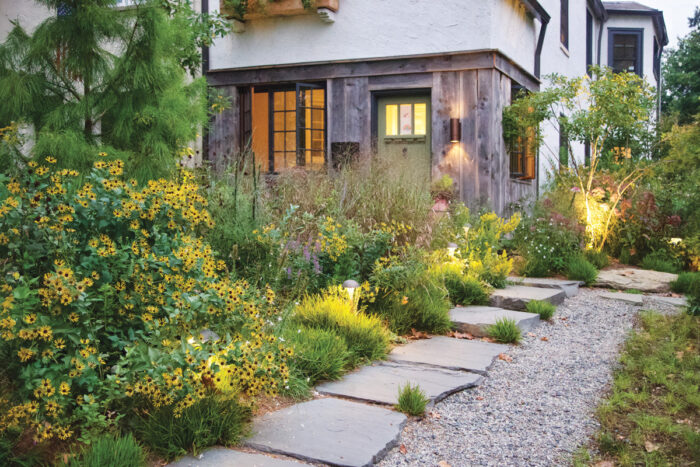
Narberth is one of many neighborhoods on the historic Main Line in Philadelphia’s western suburbs. Known as America’s Garden Capital, this area is home to a variety of public gardens, arboreta, and renowned landscapes that reflect our nation’s love for fine garden design and horticulture. Therefore, when the opportunity arose in 2018 to purchase a property in this desirable location, we seized it. What many would have seen as a neglected property, we saw as a hidden gem with much potential.
While we feel fortunate to be surrounded by so much creative inspiration, many traditional gardening practices no longer fit into our changing climate. It’s increasingly clear that gardeners must instead break some rules by creating a new paradigm that works with, rather than against, the natural world. A former rental property, our new home’s green spaces felt uninspired and were awash with bullying undesirables like English ivy (Hedera helix). We craved an immersive environment for our young family that was reminiscent of our time spent in nature. Seeking to create opportunities to both observe and be hidden, we made an outdoor refuge that was functional, resilient, and beautiful while being welcoming to all its inhabitants—people and wildlife alike.
 |
 |
Our approach was to maximize our garden’s ecological impact by using functional and resilient native trees, shrubs, perennials, and grasses, and minimize our own input by eliminating fertilizers, supplemental irrigation, annuals, and intensive maintenance. We strove to create a sustaining refuge for plants, wildlife, and beneficial insects whose habitat is increasingly fragmented. Simply put, we set the landscape to work.
Native plants are incorporated for their toughness, low maintenance, and wildlife benefits
After first removing the lawn, we regraded the entire front yard and installed a deep planting bed, which was then filled with densely layered natives. Some of the plants we included had a more southern native range to account for increasingly warming temperatures. These perennials, trees, and shrubs provide successive interest throughout the seasons as well as shelter and foraging opportunities for birds and pollinators alike. At its center, a majestic pond cypress (Taxodium distichum var. imbricarium, Zones 5–10) provides a visual anchor and a stunning autumnal show before effortlessly mulching the bed with its needles for winter (photo, top). It’s the epitome of beauty with purpose.
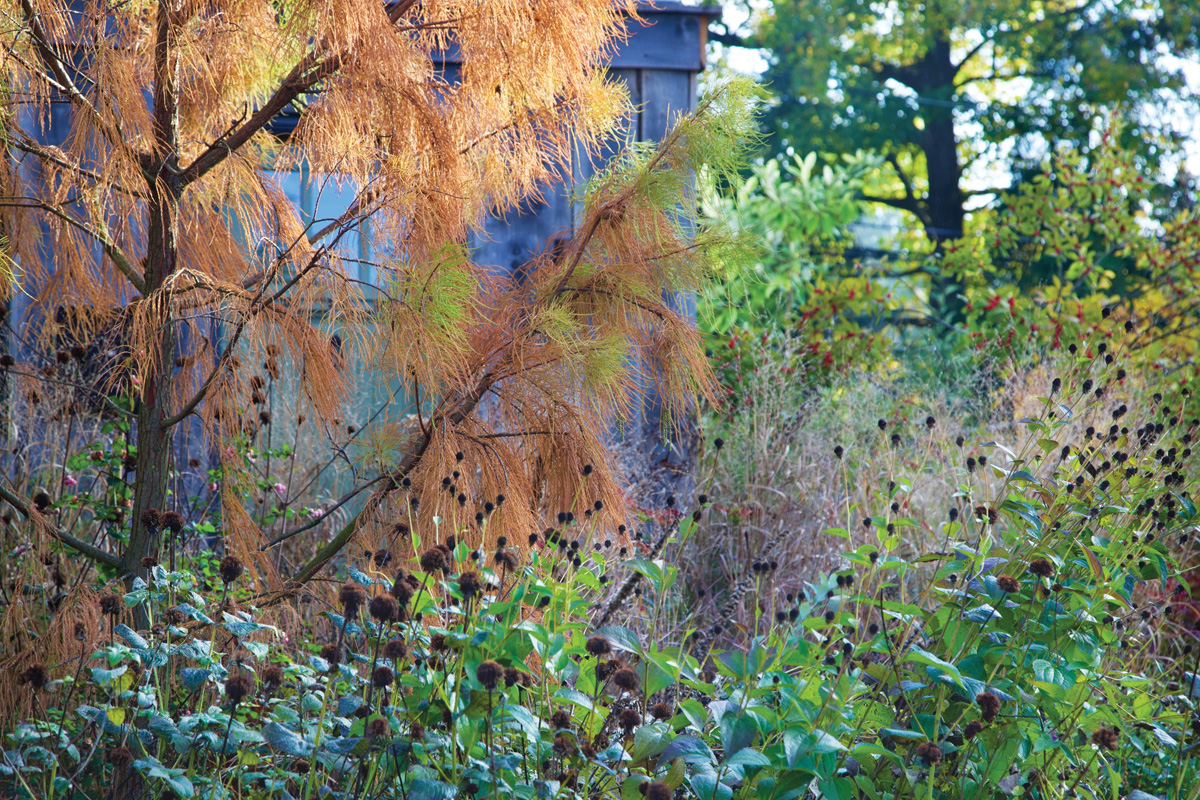
We interspersed tough and resilient structural grasses that multitask easily with their tolerance for both extreme drought and extreme wetness, which are now characteristic of our summers in greater Philadelphia. Stormwater superstars like switchgrass (Pancium virgatum, Zones 3–9) are experts at managing runoff via their root systems, which can extend three times the size of the aboveground plant.
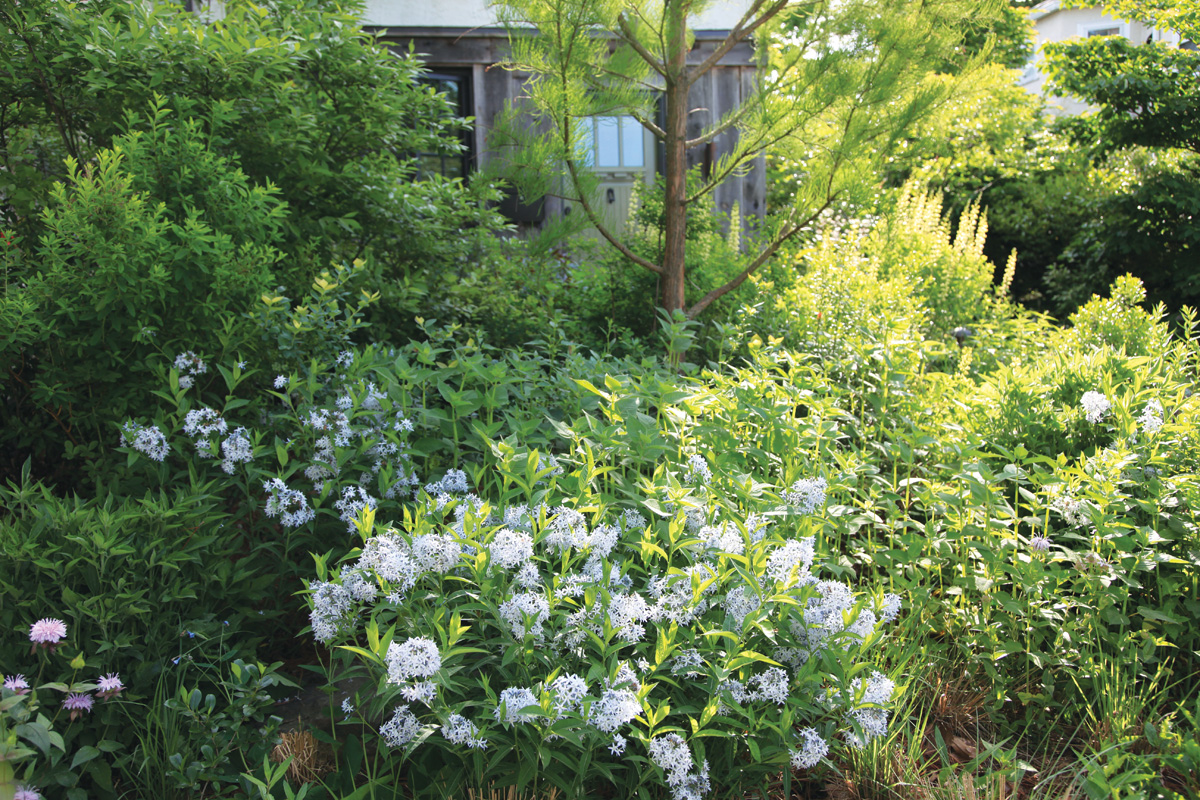
Reclaiming a garden that has been overrun by invasives is a common problem for homeowners in our locale. Quickly establishing productive plant communities is key and can be achieved with competitive species like ‘Little Henry’ sweet coneflower (Rudbeckia subtomentosa ‘Little Henry’, Zones 4–8) (photo p. 54), eastern bluestar (Amsonia tabernaemontana, Zones 3–9), and eastern beebalm (Monarda bradburiana, Zones 5–8). We planted these during our first few summers to hold ground against undesirables while the landscape established. Planting densely and allowing perennials to self-seed also created layered beds that mimic the thick planting communities found in nature, further providing ground coverage, soil stabilization, and shelter for wildlife. With the garden entering its sixth year, it now demands little in terms of traditional maintenance beyond winter pruning and late spring cutbacks (the results of which are all left as mulch alongside the duff layer of leaves and pine needles).
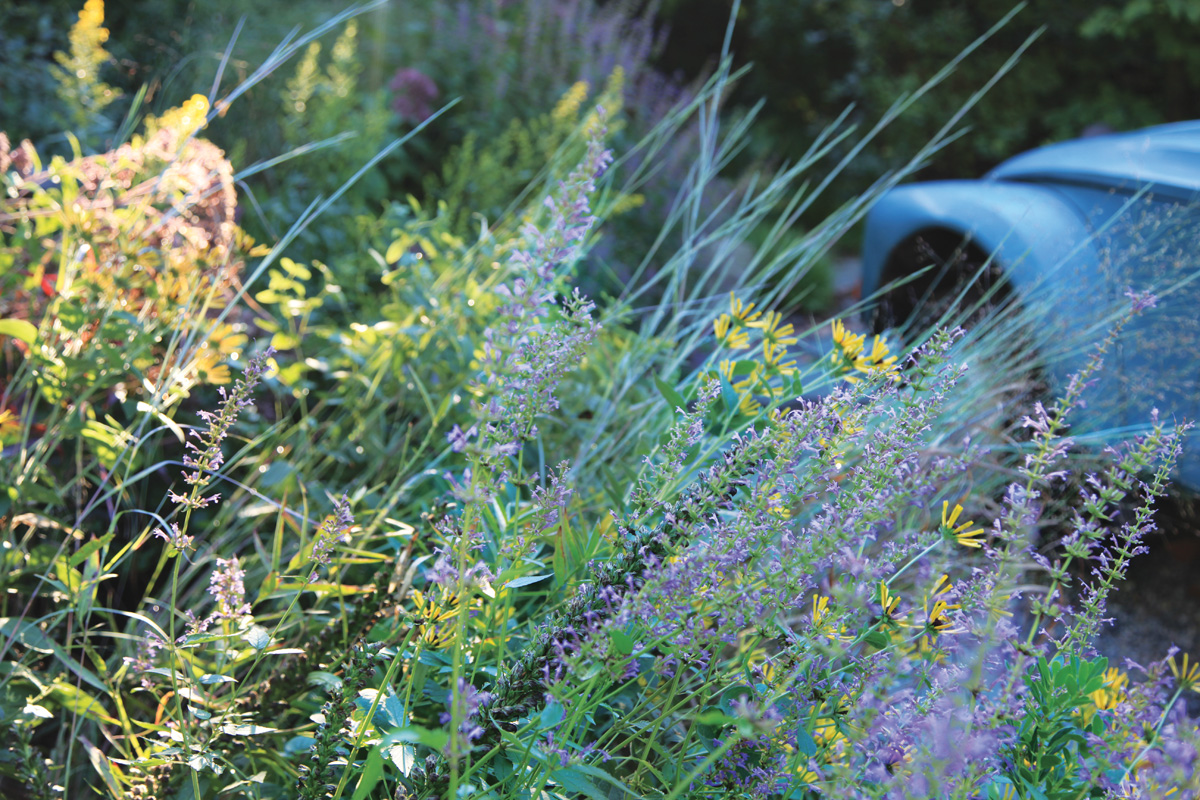
A south-facing side garden has been transformed from full sun during its initial installation (photo p. 60, top) to partial shade after filling out five years later (p. 56, top right of large photo)—which has been a huge help in cooling things down in summer. In this area, we’ve included such favorites as sweetbay magnolia (Magnolia virginiana, Zones 5–10), ‘Winter Red’ winterberry (Ilex verticillata ‘Winter Red’, Zones 3–9), Southern bayberry (Morella cerifera syn. Myrica cerifera, Zones 7–10), and pagoda dogwood (Cornus alternifolia, Zones 3–8). These plants offer excellent cover and forage for wildlife, and many are host plants. We have seen winged visitors flock to the native plants in our garden for food, nectar, and shelter. These guests include native pollinators like bumble, mason, and sweat bees; butterflies; and hummingbirds, as well as other birds like Carolina wrens, screech owls, and cardinals.
Environmentally friendly hardscape elements create a naturalistic aesthetic with purpose
There is much repetition in the materials we used when constructing this garden. Cohesion is key when integrating hardscaping or building materials in a small space like ours. Recycled barnwood was an affordable option used to clad the house’s stucco exterior as well as the outdoor kitchen on the deck at the rear. Its silvery patina is echoed in the horizontal shadow-box fence and pergola made of cedar, as well as the shade house structure and thermally modified Pennsylvania hardwood deck. This sustainably forested, locally sourced wood (versus an overharvested, exotic hardwood like Ipe) does a beautiful job of alchemizing our “cottage in the woods” inspiration.
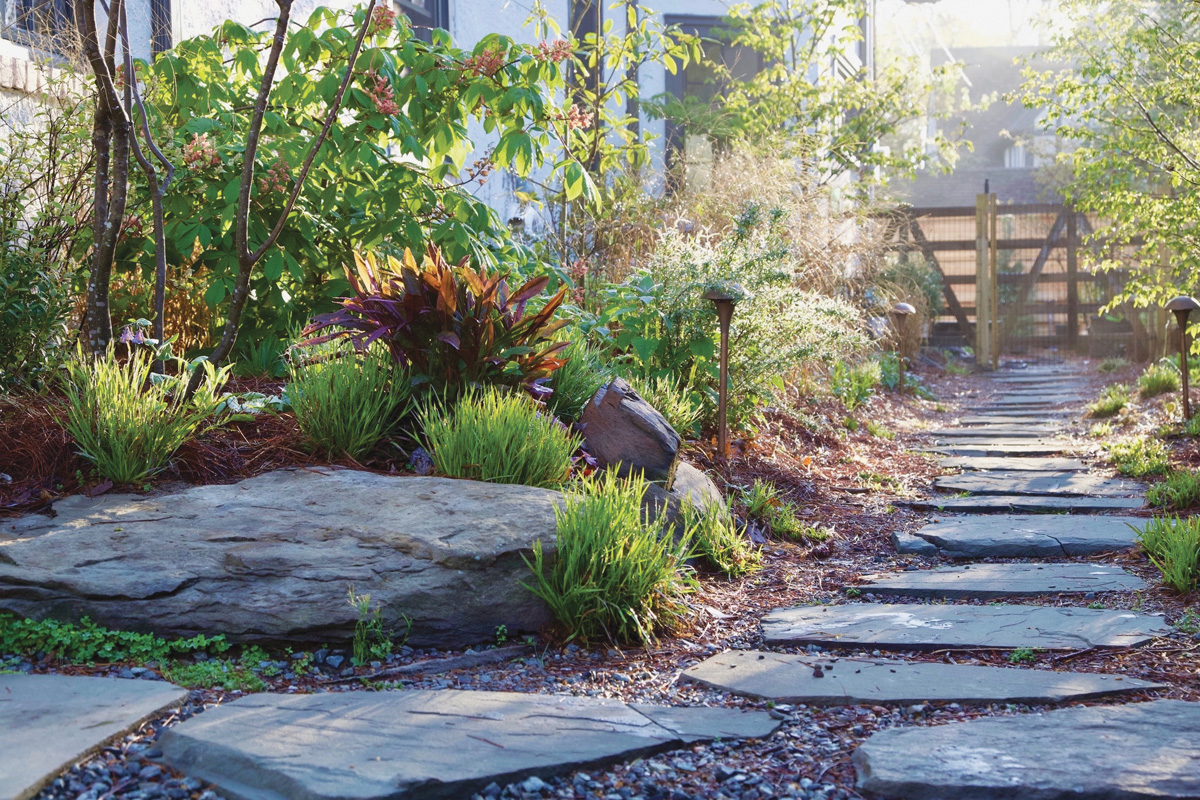
It’s equally important to be thoughtful about walkway materials. When we purchased the property, there was an impervious concrete path from the front to the backyard. We replaced this with crushed stone and irregularly placed, permeable bluestone slabs and stepping stones. Along with a French drain installed underneath the stones, this allowed us to slow, spread, and convert excessive stormwater runoff into useful “run-on” water that could be directed into the garden.
Integrating a parking spot into the redesign was a family priority due to limited street parking; a resourceful runway of Leavenworth’s sedge (Carex leavenworthii, Zones 6–9) within permeable pea gravel helps synchronize this functional element within the neighboring planting beds. This area leads directly to the bluestone pathway that takes you to the backyard.
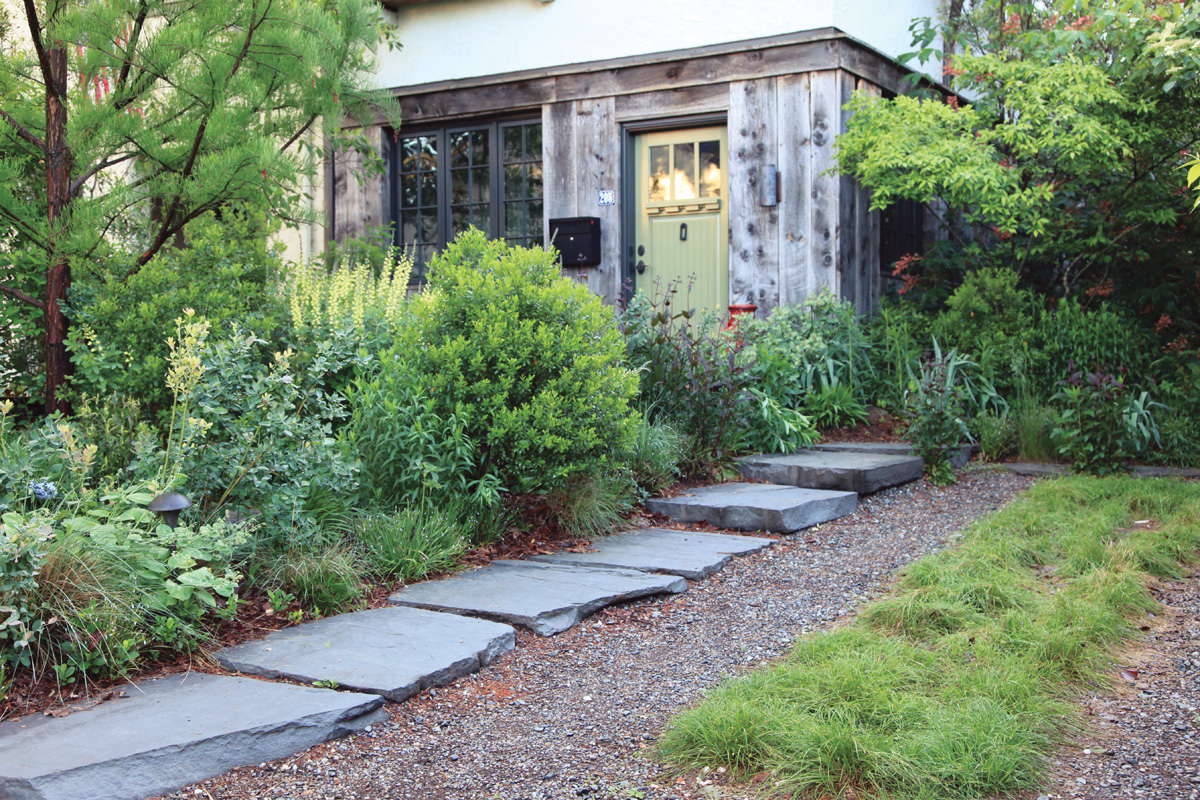
A no-mow lawn creates ecological value with reduced maintenance
Replacing a lawn with more diverse native plants is one of the most impactful actions a homeowner can take to combat climate change and loss of biodiversity. There are many native alternatives to lawn turf that do not require fertilizing, weeding, or supplemental water. We love to recruit resilient native sedges like Pennsylvania sedge (Carex pensylvanica, Zones 3–9) and Leavenworth’s sedge to help define planting bed edges and pathways.
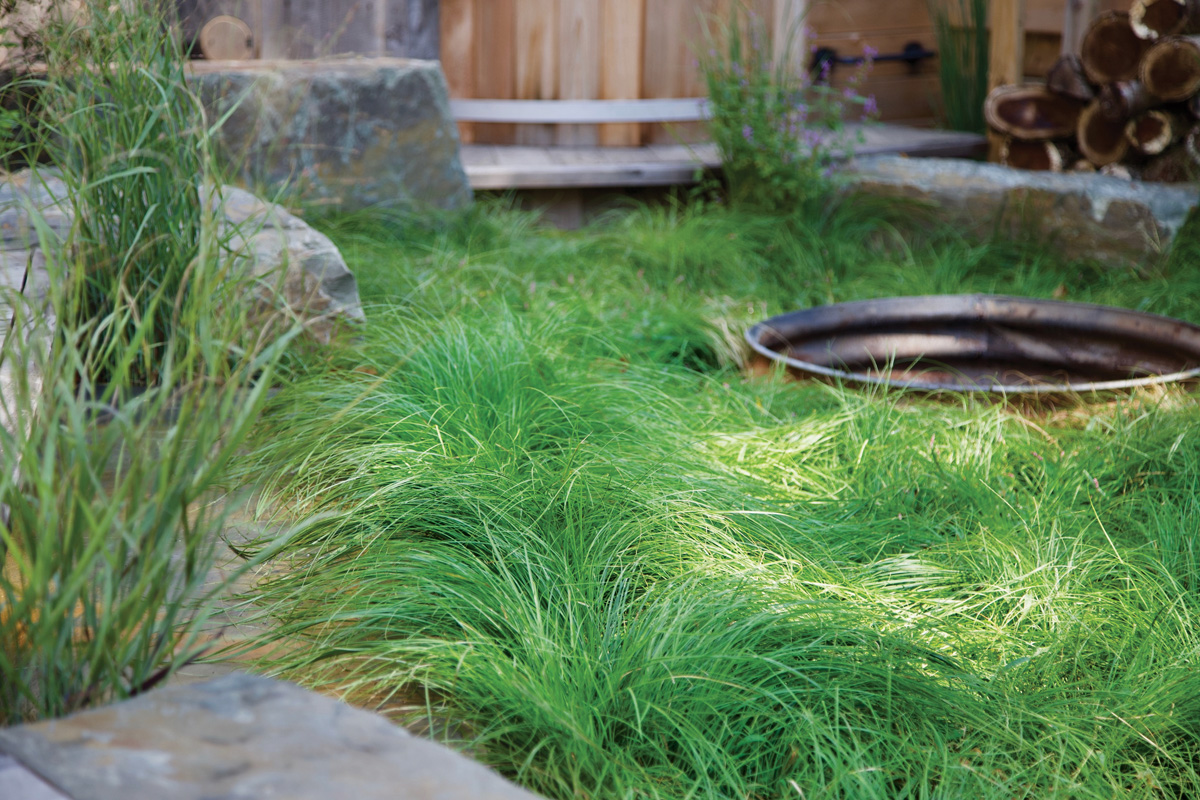
For the backyard, we’ve experimented with a combination of sedge species and a fine fescue mix (Festuca spp. and cvs., Zones 3–8) that have been both seeded and plugged. We’ve had the most success with fine fescue sod that tolerates moderate foot traffic but only requires an annual fall haircut. This open area invites space for play and family gatherings around the firepit, or reading on sun loungers surrounding it. We love the carefree look of this low-maintenance ground cover; its seed heads are so pretty in spring, and its cascading habit throughout summer stays lush in sun or shade.
Replacing lawn can feel scary for some, but thinking about how much lawn you actually use is a good place to start. Increasing your planting beds to reduce lawn over time is one tactic. Once homeowners replace an area of lawn with low-mow ground covers or perennials, they are often quick converts. We hope to inspire neighbors to rethink their own plant choices and maintenance habits by showcasing a productive habitat powerhouse in a relatively modest footprint.
| Technique |
Solve for flooding with smart hardscaping
When we first bought this property, it had major issues with flooding where stormwater exits the house. This had become more and more of a problem as rainstorms increased in frequency and intensity over the years. The permeable hardscaping, French drain, and planting design solved this problem. Here’s how:
Jeff Lorenz is the founder and Kayla Fell is the creative and communications director of Refugia Design, a Philadelphia area–based landscape design firm that prioritizes creating beautiful, functional gardens with ecological benefits and resilience in mind.
Fine Gardening Recommended Products

A.M. Leonard Deluxe Soil Knife & Leather Sheath Combo
Fine Gardening receives a commission for items purchased through links on this site, including Amazon Associates and other affiliate advertising programs.

Gardena 3103 Combisystem 12-Inch To 20-Inch Adjustable Metal Fan Rake Head
Fine Gardening receives a commission for items purchased through links on this site, including Amazon Associates and other affiliate advertising programs.

SHOWA Atlas 370B Nitrile Palm Coating Gloves, Black, Medium (Pack of 12 Pairs)
Fine Gardening receives a commission for items purchased through links on this site, including Amazon Associates and other affiliate advertising programs.










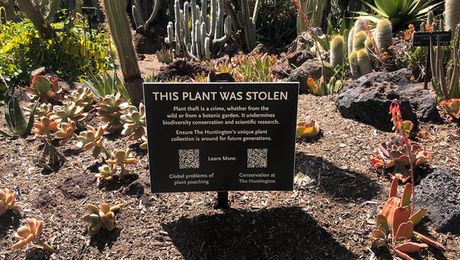











Comments
Log in or create an account to post a comment.
Sign up Log in